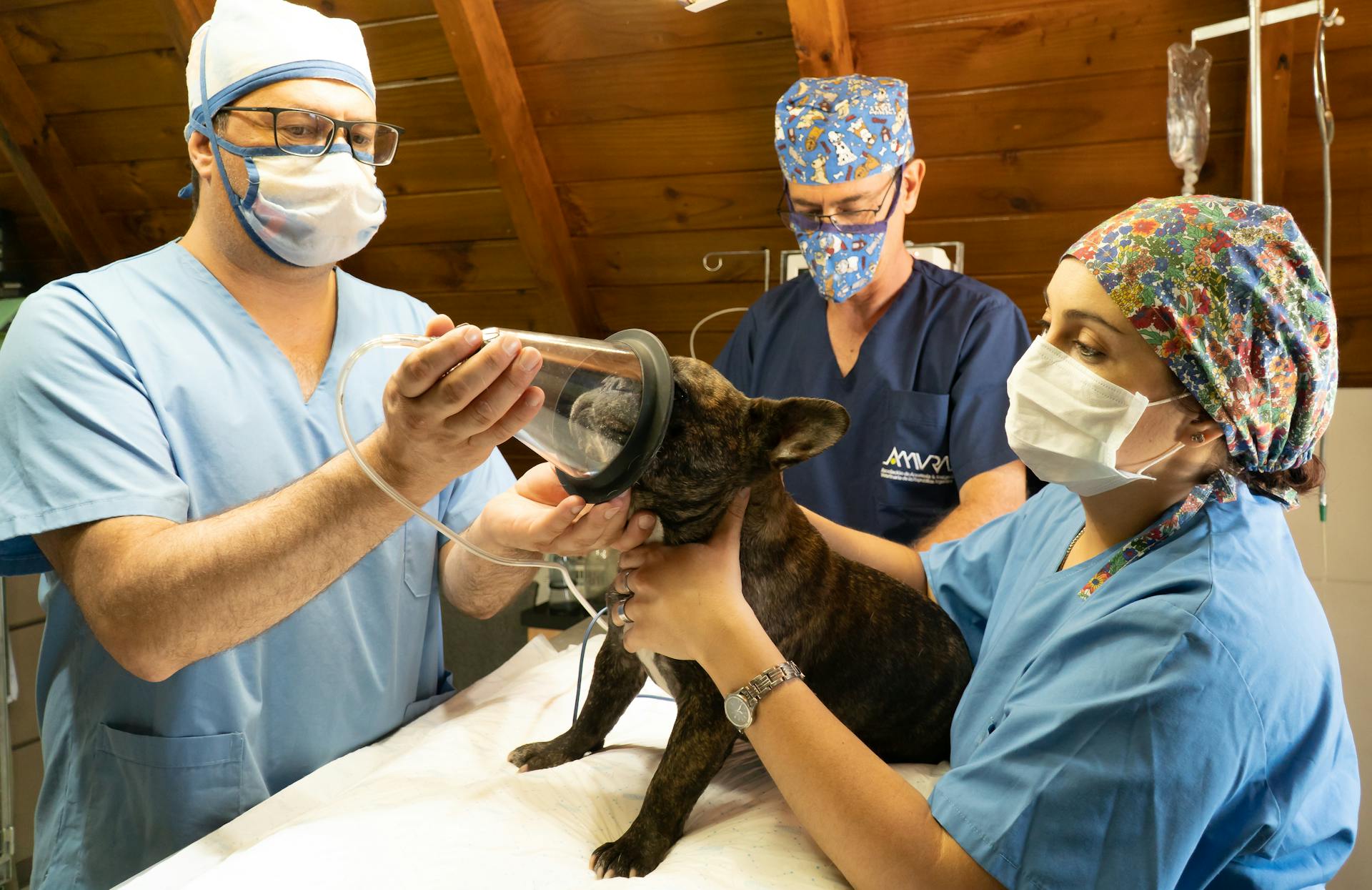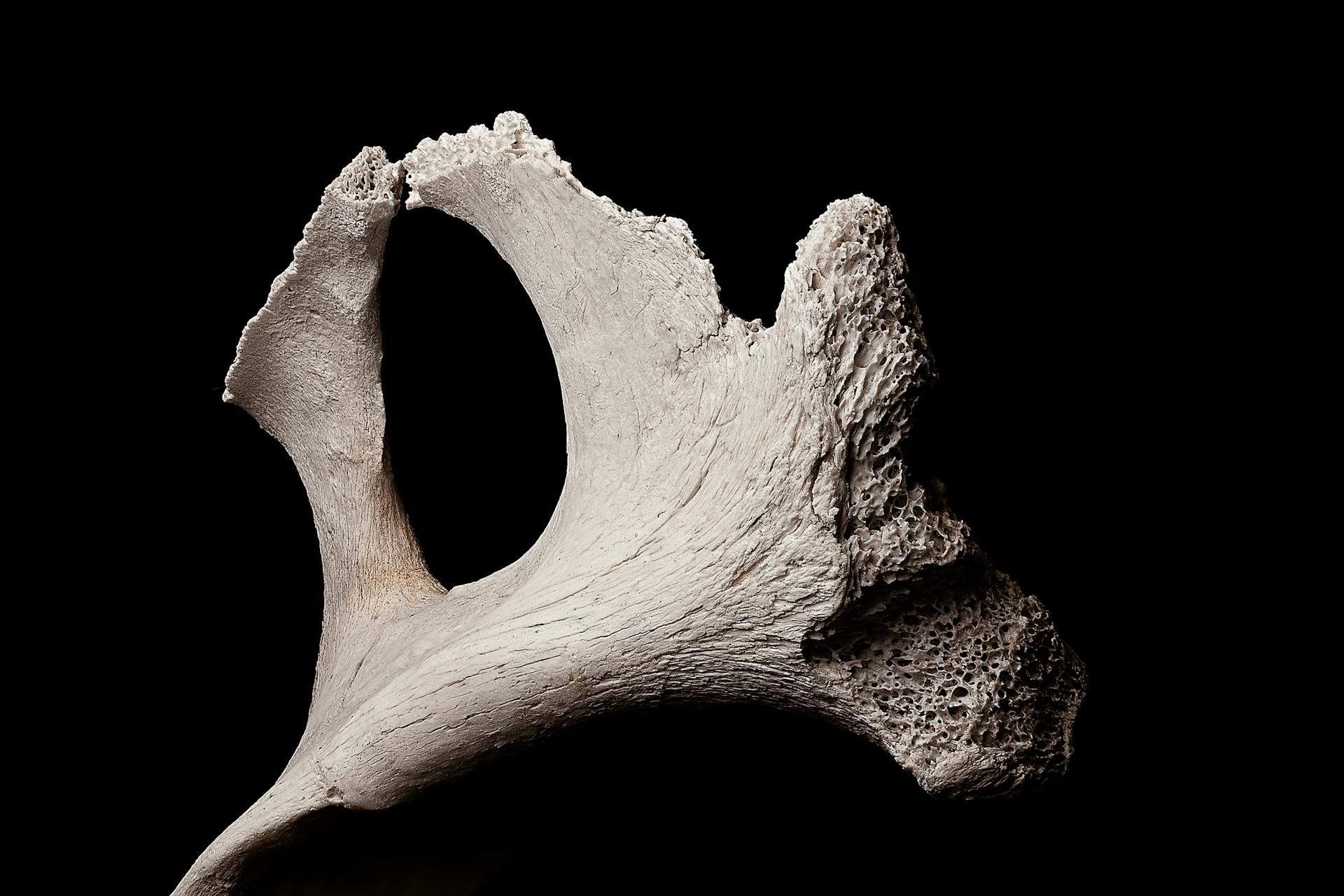
Canine bone cancer life expectancy varies depending on the type and stage of the disease.
The prognosis for dogs with osteosarcoma, a common type of bone cancer, is generally poor.
Osteosarcoma is a highly aggressive cancer that often spreads to other parts of the body, making it difficult to treat.
Surgery is often the primary treatment for osteosarcoma, but it may not be enough to cure the disease.
The 5-year survival rate for dogs with osteosarcoma is around 20-30%.
Some dogs may live longer than 5 years with proper treatment and care, but this is not common.
The life expectancy for dogs with chondrosarcoma, another type of bone cancer, is generally better than for osteosarcoma.
Chondrosarcoma tends to grow more slowly than osteosarcoma, making it easier to treat.
Recommended read: Canine Cancer Chondrosarcoma
What Is Canine Bone Cancer?
Canine bone cancer, also known as osteosarcoma, is a serious and common condition in dogs. It makes up 85% of all primary bone cancers in dogs.
Osteosarcoma typically develops in dogs around the age of 7, which is why it's essential to monitor your dog's health closely as they age. Giant and large breed dogs are more likely to develop osteosarcoma compared to smaller dogs.
Certain breeds are more prone to osteosarcoma, including Rottweilers, Great Danes, St. Bernards, Irish Setters, Doberman Pinschers, German Shepherds, Rhodesian Ridgebacks, and Golden Retrievers.
Explore further: Canine Age Chart
Symptoms and Diagnosis
Symptoms of canine bone cancer can be quite subtle at first, but they can quickly become severe and debilitating. The most common symptom is acute lameness and swelling of the affected leg.
Osteosarcoma can cause a range of other symptoms, including fever, reduced appetite, and weight loss. These symptoms can be caused by the cancerous cells growing and pushing against the surrounding tissue or because the bone cancer has weakened the bone and made it susceptible to pathological fracture.
A physical exam, blood tests, and x-rays are usually performed to diagnose bone cancer. Unfortunately, 80-90% of dogs diagnosed with osteosarcoma already have microscopic spread to the lungs, but these lesions can't be detected with X-rays or a CT scan.
Dogs Symptoms
Dogs with osteosarcoma often experience acute lameness and swelling of the affected leg.
The symptoms can be caused by the cancerous cells growing and pushing against the surrounding tissue or because the bone cancer has weakened the bone and made it susceptible to pathological fracture.
Fever is another common symptom of osteosarcoma in dogs.
Reduced appetite and weight loss can also be indicative of the disease.
A firm swelling may become evident as the tumor grows, especially in tumors involving the limbs.
Pain can cause irritability, aggression, and loss of appetite in dogs with osteosarcoma.
Weight loss is a common problem associated with the disease.
Dogs with osteosarcoma may whimper, show restlessness, or reluctance to exercise due to the pain.
You might enjoy: What Is Canine Lupus
Cancer Diagnosis in Dogs
Diagnosing cancer in dogs can be a complex process, but it's essential to determine the right treatment and prognosis for your furry friend.
A complete physical exam is the first step in evaluating a dog suspected of having a bone tumor, such as osteosarcoma. This exam helps identify any abnormalities and establishes a baseline for future monitoring.
Blood work, including a complete blood count and serum chemistry profile, is also crucial in diagnosing bone cancer in dogs. These tests can reveal changes that affect prognosis and assess a patient's overall health.
X-rays are commonly used to evaluate bone tumors, but unfortunately, 80-90% of dogs diagnosed with osteosarcoma already have microscopic spread to the lungs that can't be detected with X-rays or a CT scan.
A CT scan may be recommended to evaluate for metastasis and/or surgical planning, but it's not a guarantee to detect all microscopic lesions. In some cases, osteosarcoma is initially misdiagnosed as another cause of lameness, but is later found to be bone cancer.
To confirm a diagnosis of osteosarcoma, sampling the bone lesion by either cytology or biopsy is usually necessary. This involves taking a fine needle aspirate sample or a tissue sample for histopathology.
Diagnosis is usually confirmed with a combination of supporting clinical findings, imaging, and histopathology. The results of these tests will allow veterinarians to develop individualised treatment recommendations for your dog.
Expand your knowledge: Canine Cancer Screening Test
Treatment Options
Amputation is often the best way to treat local disease caused by bone cancer in dogs, as it alleviates pain and prevents the affected limb from breaking. This surgery is surprisingly well-tolerated by dogs, who can adapt quickly to living on three legs and enjoying activities like walks, playtime, and swimming.
For dogs like Ella, a 10-year-old Jack Russell Terrier who underwent amputation followed by chemotherapy, amputation alone can result in a median survival time of about 5 months. However, amputation followed by chemotherapy can significantly improve life expectancy, with a reported median survival time of 10 to 12 months and approximately 20% of dogs alive more than 2 years later.
Chemotherapy is a crucial follow-up to surgery for dogs with appendicular osteosarcoma, as it can significantly prolong their quality of life. The most common chemotherapy agent used is Carboplatin, administered intravenously once every three weeks for 6 doses.
Palliative options are available for dogs, focusing on alleviating pain and clinical signs. These options include oral medications, IV bone supportive medications called bisphosphonates, and radiation therapy.
For your interest: Hemangiosarcoma in Dogs Survival Rate
If you're considering treatment options for your dog, it's essential to weigh the pros and cons of each approach. Here's a summary of the treatment options and their approximate costs:
Remember, every dog is unique, and the best treatment option will depend on your dog's individual needs and circumstances. Consult with your veterinarian to determine the most effective course of treatment for your furry friend.
Cancer in Dogs: Treatment and Survival Rates
Cancer in dogs can be a devastating diagnosis, but with the right treatment, many dogs can live happy and healthy lives for a significant amount of time.
Treatment for osteosarcoma in dogs typically involves two main goals: managing pain and treating the primary tumor, as well as addressing the risk of metastatic disease.
Pain management is often achieved through a combination of medication and surgery, such as amputation.
Amputation is a common and effective treatment for osteosarcoma in dogs, and it can significantly improve their quality of life.
Explore further: Canine Cancer Pain Management
In fact, many dogs adjust well to living with three legs and can still enjoy activities like walking, playing, and even swimming.
However, amputation alone is not enough to prevent the growth of cancer spread, which is why chemotherapy is often recommended as a follow-up treatment.
Chemotherapy can slow the growth of cancer spread and dramatically improve life expectancy, with some dogs living for 2 years or more after treatment.
The most common chemotherapy drug used to treat osteosarcoma in dogs is Carboplatin, which is administered intravenously every 3 weeks for 6 doses.
Most dogs tolerate chemotherapy well, with less than 10% experiencing significant side effects.
Here's a summary of the average survival times for dogs with osteosarcoma:
These statistics highlight the importance of seeking prompt and effective treatment for osteosarcoma in dogs.
Managing Side Effects and Costs
Managing side effects is crucial for your furry friend's comfort during treatment. Side effects are associated with the treatment modality selected, such as surgery, radiation therapy, or chemotherapy.
Recovery from anesthesia and brief hospitalization are required with any surgical procedure. This means your pet will need time to rest and recover. Risks include those associated with any form of anesthesia and surgery, like fracture in patients who undergo limb salvage procedures.
Chemotherapy side effects are infrequent but can include temporary mild gastrointestinal upset like vomiting or diarrhea. Decreased appetite and lethargy may also occur. Your oncology team is available to assist if you have any questions about managing these side effects.
Palliative Options
Palliative options are available for dogs to alleviate pain and clinical signs. These options can significantly improve your pet's quality of life.
Oral medications can be prescribed to manage pain and discomfort. They can be an effective way to keep your dog comfortable at home.
IV bone supportive medications called bisphosphonates can also be administered to help alleviate pain and clinical signs. They work by reducing the risk of bone fractures and pain.
Radiation therapy may be recommended to provide pain relief. A course of radiation therapy can be provided to help manage pain and improve your dog's quality of life.
Treatment recommendations for bone tumors, such as osteosarcoma, depend on multiple factors and the ultimate goal is to help improve your pet's quality of life.
Side Effects
Side effects are a natural part of cancer treatment, and it's essential to be aware of what to expect.
Recovery from anesthesia and brief hospitalization are required with any surgical procedure, and risks include those associated with any form of anesthesia and surgery.
Surgical procedures like limb salvage can increase the risk of fracture, so it's crucial to follow your veterinarian's instructions carefully.
Radiation therapy also includes the use of anesthesia during treatments, but the side effects are generally minimal.
Chemotherapy can cause temporary mild gastrointestinal upset, including vomiting or diarrhea.
Decreased appetite and lethargy are also possible side effects of chemotherapy.
Your veterinarian may prescribe supportive medications for nausea, decreased appetite, or diarrhea to help manage these side effects.
It's best to be proactive with these medications and administer them as soon as signs are noted.
Should you have any questions or concerns, your oncology team is available to assist.
Financial Limitations
If you have limited funds, discussing available treatment options and costs with your veterinarian or a pet cancer specialist is crucial. You can work directly with your veterinarian to get individualized treatment recommendations.
At The Pet Oncologist, a comprehensive written report will be provided within one to two business days, including an interpretation of results, details about the cancer's biologic behavior, prognosis, and multiple treatment options.
Your veterinarian will be able to discuss all these options with you before considering treatment and can contact The Pet Oncologist with any questions or concerns. Unfortunately, due to legal reasons, pet owners cannot receive online pet cancer advice directly from The Pet Oncologist.
Frequently Asked Questions
Does bone cancer spread fast in dogs?
Bone cancer in dogs can spread rapidly, making prompt treatment essential. If you suspect your pet has bone cancer, seek immediate veterinary attention.
Is bone cancer aggressive in dogs?
Bone cancer in dogs is extremely aggressive, with cancer cells often spreading to other parts of the body even before diagnosis. This makes prompt treatment crucial for the best possible outcome.
Sources
- https://avim.us/understanding-osteosarcoma-in-dogs/
- https://www.kingsdale.com/the-devastating-truth-about-osteosarcoma-in-dogs
- https://www.thepetoncologist.com/faqs-bone-cancer-in-dogs
- https://www.vetspecialists.co.uk/fact-sheets-post/canine-osteosarcoma-fact-sheet/
- https://hospital.cvm.ncsu.edu/services/small-animals/cancer-oncology/oncology/bone-tumors/
Featured Images: pexels.com


